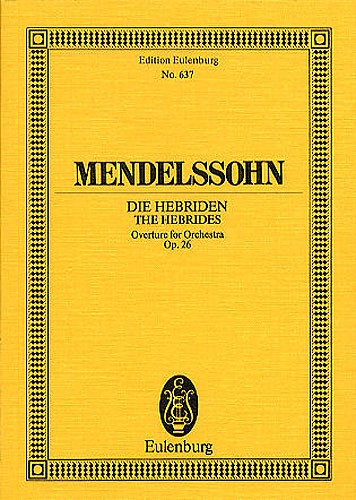The Hebrides, Op. 26 "Fingal's Cave"
An aural and visual exploration of Felix Mendelssohn's famous Hebrides overture

Introduction
The concert overture The Hebrides (German: Die Hebriden), Op. 26, also known as Fingal's Cave (Die Fingalshöhle), was composed by Felix Mendelssohn in 1830. The second edition of this Overture was completed on June 1832. The piece was inspired by Mendelssohn's visit to Fingal's Cave on the island of Staffa, located in the Hebrides archipelago off the west coast of Scotland. As was common in the Romantic era, this is not an overture in the sense that it precedes a play or opera; it is a concert overture, a stand-alone musical selection, and has now become part of standard orchestral repertoire. The piece was dedicated to King Frederick William IV of Prussia (then Crown Prince of Prussia).
Background
Mendelssohn's first visit to England in 1829 resulted from invitations by Sir George Smart and the Philharmonic Society.[1] Following his tour of England, Mendelssohn proceeded to Scotland, where he began work on his Symphony No. 3, Scottish. He was engaged on a tour of Scotland with his travelling companion Karl Klingemann when he sent a postcard to his family with the opening phrase of the overture written on it. In a note to his sister, Fanny Mendelssohn he said: "In order to make you understand how extraordinarily the Hebrides affected me, I send you the following, which came into my head there." The cave at that time was approximately 35 feet (11 m) high and over 200 feet (61 m) deep, and contained black basalt pillars.
The work was completed on 16 December 1830 and was originally entitled Die einsame Insel (The Lonely Island). However, Mendelssohn later revised the score, completing it by 20 June 1832,[4] and renamed the piece Die Hebriden (The Hebrides). Despite this, the title of Fingal's Cave was also used: on the orchestral parts he labelled the music The Hebrides, but on the score Mendelssohn labelled the music Fingal's Cave. The overture was premiered on 14 May 1832 in London, in a concert that also featured Mendelssohn's Overture to A Midsummer Night's Dream.
Score
Description
The Hebrides Overture is in the Romantic tradition of a stand-alone concert overture rather than being an introduction to an opera, or a prelude to a collection of incidental music. It has been described as a tone-poem which reflects the subject of its title, in this case the “oil and seagulls and dead fish” that were such a vivid part of Mendelssohn’s experiences when he travelled to the Western Isles of Scotland.
The Overture loosely follows the pattern of “sonata form” with 1st subject in the tonic (B minor), 2nd subject in the relative major (D major), development section, recapitulation and coda, although the impression is of a free-flowing work which is not restricted or inhibited by formal considerations. The main subjects of the entire work are contained in the opening few bars that Mendelssohn wrote down in Tobermory and the work is the closest example of Mendelssohn taking a monothematic approach to sonata form (although the many themes in his A Midsummer Night’s Dream Overture are also discernible in the opening chords of that great work of his teenage years).
The shift from B minor to D major to F minor in the opening six bars give a stark impression; in fact, such parallel moves from one key to another over a short space of time would be something that Mendelssohn, the supreme master of counterpoint and observer of all the “rules”, would normally have avoided at all costs, but here they reflect the primitive bleak beauty of the many islands in the Hebrides that affected him so extraordinarily.
It is difficult to resist the idea that Mendelssohn’s overture is a representation in music of the visual and aural experiences that he had in Hebrides. The calmness of the oscillating accompanying semi-quaver figures that grow out of the opening theme are interrupted by the rising surges in the cellos and basses which give a strong feeling of a sea swell, with waves pushing against a boat or breaking on the shore; in the development section, those same oscillations accompany bleak declamatory exchanges across the orchestra which suggest the vastness of the landscape and seascape, punctuated by the cry of gulls – you never know where the next sound is coming from. And we get a storm towards the end of the development section, such as Mendelssohn will have experienced on his trip out to Staffa.
One of the magical moments in the Overture is the restatement of the beautiful second subject near the end. Originally given to the cellos in the exposition, it is now taken up by first one clarinet, soon joined by a second. The sense of calm is in great contrast to the storm that has gone before and the following headlong rush to the end of the Overture. Anyone who has travelled around the Hebrides will be familiar with these sudden variations in the weather which can change from harsh wind and rain, to serene stillness and back again in a short space of time.
Make The Hebrides Your Own
The Overture was conducted at its premiere in London by Thomas Attwood, Mozart’s former pupil. Think you can do as well as a pupil of Mozart? Tap below to set the tempo and explore the piece at your own speed.
Current tempo: 98 bpm
Have a mobile device available? Use it to conduct your orchestra!
- Navigate here on your mobile device - confirm your device supports gathering accelerometer data by conducting a measure at your own tempo.
- Tap here to sync with your mobile device and use it as a conducting baton:
What's Next?
In the next section we will get to know one of Mendelssohn's most famous contemporaries, Franz Schubert, by exploring his Sonata in A minor for arpeggione and piano, D 821
Built by @uptownnickbrown, check out my other projects at uptownnickbrown.com